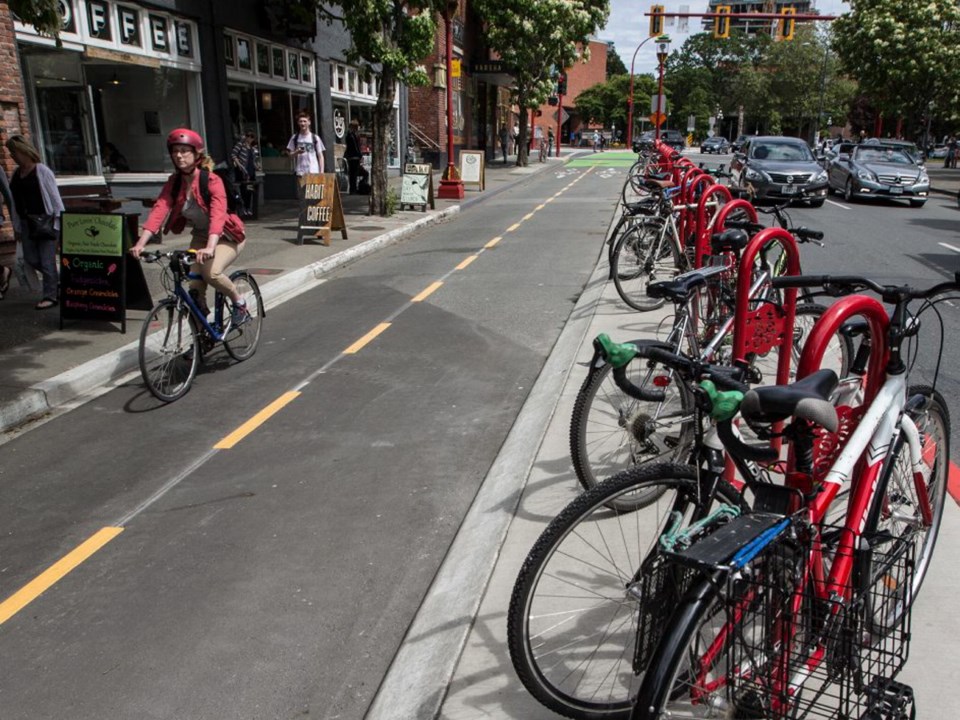In Victoria, any new policy or project that has to do with bicycles is sure to poke the hornet’s nest. Just after the city irritated drivers by urging shoppers to leave their cars at home this Christmas, staff gave the nest another poke when they said it would take another $3 million to finish the first phase of the network of separated bike lanes.
The city’s plan is to build 5.4 kilometres of separated lanes downtown. The lanes, called All Ages and Abilities, are designed to encourage cycling by giving riders safe, convenient access to the core along major traffic routes.
Two-way lanes on Pandora Avenue were the first, followed by Fort Street. The city says that in the first six months of the Pandora lane, users made almost 250,000 trips. The current daily average is 1,500, and staff expect that to increase when the new Johnson Street Bridge opens next year.
The rest of the first phase includes two-way protected bike lanes on the west side of Wharf Street from the Johnson Street Bridge to the intersection of Wharf and Government Street; two-way protected bike lanes on the south side of Humboldt Street between Government and Douglas streets and one-way protected bike lanes on both sides of Cook Street from Pandora to Pakington Street.
Eventually, the plan is for 32 kilometres of lanes.
The city originally allocated $7.75 million for the first phase, but the new estimate is $14.5 million. Quick arithmetic works out to $2.7 million a kilometre. That’s enough to make many a driver — and even some cyclists — choke on their morning coffee.
However, the city says the outlying parts of the network will be cheaper. That will be reassuring for taxpayers, but the costs so far have been much higher than planned.
Pandora was supposed to cost about $1.09 million, but came in at $2.4 million. Fort was projected at $2 million, but is expected to be $3.27 million. Wharf, Humboldt and Cook are expected to cost $7.85 million, significantly more than planned.
A booming construction industry drove up costs, and other increases happened because once work began on a street it made sense to make other needed changes at the same time, such as improved signals, pedestrian facilities, on-street parking and public spaces.
As Pandora was more than double the planned cost, and all the others are well over projections, it’s hard for taxpayers to have confidence for the future of the network. At least some of the additional improvements should have been foreseen and included in the original cost estimates.
Of course, for many, the cost is just an aggravation of a much bigger injury: the bike lanes themselves.
While cyclists welcome the safety of the lanes, many drivers and business-owners find them frustrating and inefficient tools to force the wishes of the few onto the majority. Statistics sa���ʴ�ý figures from the census showed that 6.6 per cent of commuter trips in Victoria were by bicycle.
Victoria city council is trying to change attitudes toward transportation, encouraging commuters to pick two wheels over four to protect our health and the environment. Changing minds is never easy, and trying to do it with concrete and blacktop stokes the resentment, so managing public perceptions matters.
With the Pandora experience to draw on, the city has to make it a priority to get some better numbers for the rest of the project and tell taxpayers what the total bill is likely to be. Then stick to those numbers.
Every time the cost ticks up unexpectedly, it pokes the hornets into another frenzy.



